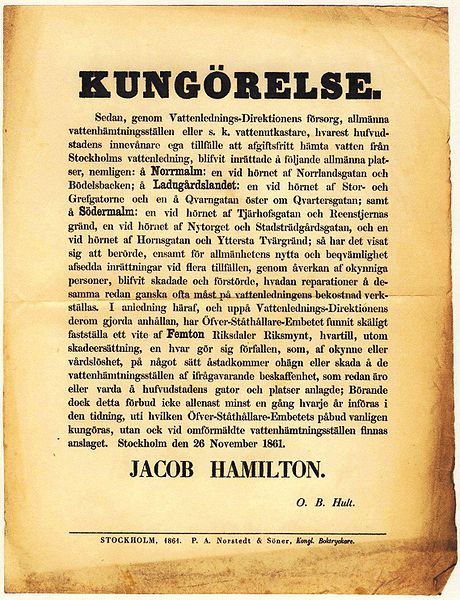Internet access and clean water
Patrik Fältström, Technical Director, Netnod
It was not until 1861 that Stockholm had its first distribution mechanism for water. This was announced in November 1861 when local inhabitants were informed where and how they could get water. In 1920 water toilets became standard but it took until the 1970s for the last homes to have them installed.
One of the main reasons for this development was that the relationship between illnesses and clean water became increasingly known. This included, but was not limited to, the repeated cholera pandemics. The first pipes did not go into the houses, and there was no distribution of warm tap water. The city’s sewer systems were built out which enabled the connection of toilets.
1861 Announcement. Source: Stockholms Stadsmuseum, via Wikimedia Commons.
The main reason for the water and sewer system was health, but as a secondary effect it enabled, among other things, the industry related to bathrooms, water and heating. At the same time, increased access to water also enabled businesses ranging from breweries and laundries to heavy industry like steel. Today we also see water used in city-wide central heating and cooling systems.
All of these secondary effects were made possible due to the access to clean water. Even if most people do not know the technical details of how clean water is made accessible (e.g. sewage treatment systems, desalination plants etc.), they can appreciate the importance of these processes. At the same time, they can see that the group of people innovating and operating sewage treatment systems are not the same people who are working with innovation regarding bathroom design.
We have a similar situation with Internet access. Clean Internet access is an enabler for the innovation and development of many other industries in the same way as clean water was an enabling function. And just as there are special groups of people working with effective sewage treatment, so there are special groups working to enable effective Internet access. While the former have no expertise in decorating bathrooms, the latter are not involved in making effective applications.
We could also consider electricity as something we today take for granted. We see a wall outlet, have a device in our hand with a cable that seems to have the correct physical shape, we plug the device in, and things happen. Behind the wall outlet, just like the water tap, there is a whole system of infrastructure, organisations, private and public companies, authorities, rules and regulation that ensure things just work.
Both the water and electricity infrastructure systems emerged in the middle of the 19th century, but took many, many years to become something that was a general feature in all homes instead of just a luxury.
Today good Internet access is a luxury. We do see indications that good Internet access might end up being the norm instead of an exception. But so far the quality of the access has been of such a low quality that applications and innovations that depend on Internet access have had to adapt to the quality delivered instead of being delivered over some general agreed-to quality.
Digitalization of society implies changes, which have been made possible thanks to a combination of the transformation to and from ones and zeros, and the ability to move this digitized data over the Internet. The advent of these two innovations at the same time can make existing processes much more effective in a way we have not seen since the impact of industrialization on our society during the 19th century.
Unfortunately, what we see today is a greater interest in making silos instead of a lasagna. The Internet Architecture Board view this as a consolidation that is going on. We see this, for example, in the form of different, non-interoperable systems for text messaging (or chat), or the fact that one can not choose between competing providers of services after selecting a service.
Luckily the consolidation has, so far, happened above Internet access in the value chain. This implies that the current Internet access seems good enough to enable competition between the various incompatible services. But one could see the various discussions about network neutrality (and the triggers for those discussions) as attacks against this historically clear separation between digitalization and the Internet.
This separation is important. It is at least as important as the separation between the management of clean water, or electricity, and the various processes, tools and innovations that are possible and/or enabled by this management.
With the Internet access providers have delivered so far, we have already seen the beginning of the changes possible thanks to digitalization. But when good internet access becomes as normal and common as electricity and clean water, that is when we will see real transformations in society.

